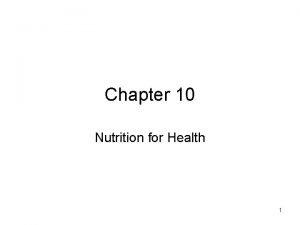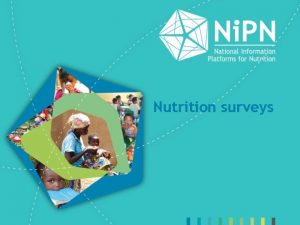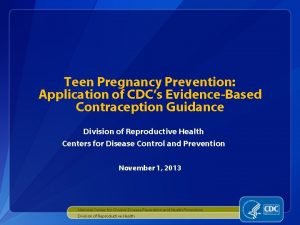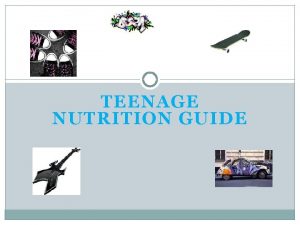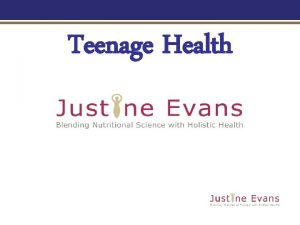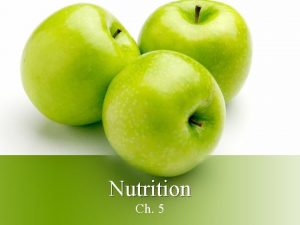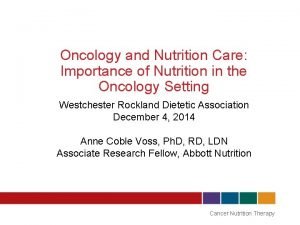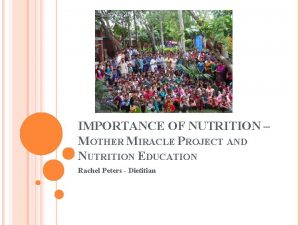Nutrition during Teenage Years The Importance of Good















































- Slides: 47

Nutrition during Teenage Years

The Importance of Good Nutrition – the process by which the body takes in and uses food. Calories(kilocalories) – are units of heat that measure the energy used by the body and the energy that foods supply to the body. Nutrients – the substances in food that your body needs to grow, to repair itself, and supply you with energy.

What Influences Food Choices Taste, of course, plays a role in choice of foods. You will probably not eat a food it you do not like the taste. Food is sometimes used to meet emotional needs. When you feel stressed, frustrated or depressed, do you snack? Food also may be a reward for you. Other may lose interest in eating if upset. However, you may miss getting enough nutrients.

Appetite and Hunger – an unlearned, inborn response, is a natural physical drive that protects you from starvation. When you stomach is empty the walls contract and stimulate nerve endings. When food is in the stomach, the nerve ending are stretched and no longer stimulated. Appetite – is a desire, rather than a need to eat.

Food and Your Environment Family, Friends, and Peers – many of your eating habits were shaped when you were growing up. By adults who planned your meals. Cultural and Ethnic Background – your food choices may reflect your cultural heritage or ethnic background. Convenience and Cost – convenience can cost of food may be top priorities fro some people. Advertising – Advertisers spend millions of dollars each year to influence your decisions about food.

Nutrition Throughout Life Healthful eating provides you with the nutrients that you need for growth and development. Gives you energy for sports. Enables you to stay mentally alert. Lowers risk of developing conditions like heart disease, strokes, certain cancers, and osteoporosis.

Nutrients To survive, the human body needs the nutrients found in food. These nutrients can be classified into 6 groups 1. Carbohydrates 2. Proteins 3. Fats 4. Vitamins 5. Minerals

Carbohydrates - Are the starches and sugars present in food. Carbohydrates are the body’s preferred source of energy. Provide 4 calories per gram. 55 to 60% of your daily calories should come from carbohydrates, mainly complex carbohydrates.

Simple and Complex Carbohydrates Simple carbohydrates are sugars such as fructose, lactose, and sucrose. Complex carbohydrates or starches are found in whole grains Examples: seeds, peas, beans, and root vegetables like potatoes.

Role of Carbohydrates Your body converts all carbohydrates into glucose. This simple sugar is the body’s main energy supply. Glucose that is not used right away is stored as glycogen. When more energy is needed, the body will turn this glycogen back into glucose. When the body takes in more carbohydrates than it can use right away or store as glycogen, the body will store the excess carbohydrates as body fat.

Fiber – is an indigestible complex carbohydrate. Fiber is found in the tough and stringy parts of vegetables and fruits. Also in whole grains. Fiber helps move waste through the digestive system and thereby helps prevent intestinal problems such as constipation.

Proteins – nutrients that help build and maintain body cells and tissue. Provide 4 calories per gram. Proteins are made of long chains of substances called Amino Acids. Your body manufactures 11 of the 20 amino acids. The 9 that your body does not make are essential amino acids, you must get these from the foods that you eat.

Complete and Incomplete Proteins Complete Proteins – contain adequate amounts of all 9 essential amino acids. Animal products like meat, fish, milk cheese. Incomplete Proteins – lack one or more of the essential amino acids. Sources include beans, peas, nuts, and whole grains.

Role of Proteins During major growth periods, proteins build new cells and tissues. Throughout life your body will replace damaged or worn-out cells by making new ones from proteins. Proteins can also supply the body with energy, but they are not the main source of energy like carbohydrates.

Fats Lipid – a fatty substance that does not dissolve in water. Lipids are necessary for good health. Provide 9 calories per gram. The building block of fats are called fatty acids. The fatty acids the body can not produce are called essential fatty acids, and must get these from food.

Saturated and Unsaturated Fats Saturated Fatty Acid – hold all the hydrogen atoms that it can. Usually a solid at room temperature. High intake of saturated fats is associated with increased risk of heart disease. Unsaturated Fatty Acid – has at least one unsaturated bond or a place where hydrogen can be added to the molecule. Are usually liquid at room temperature. Unsaturated fats intake has a decreased risk for heart disease.

The Role of Fats Transport vitamins A, D, E, and K in you blood. Serves as source of linoleic Acid, an essential fatty acid needed for growth and healthy skin. They help satisfy hunger longer than other nutrients. They also add flavor to food because they take longer to digest then carbohydrate and proteins. Fats should be 20 -30% of you total calorie intake.

The Role of Cholesterol is a waxy lipid like substance that circulates in blood. Your body uses the small amount it manufactures to make cell membranes, nerve tissue, produce many hormones, bile, and help digest fats. Excess blood cholesterol is deposited in the arteries and increases the risk of heart disease. Two Types LDL (Bad)- These is the cholesterol that builds in the arteries. HDL (Good)- These carry excess cholesterol back to the liver to be eliminated.

Vitamins – compounds that help regulate many vital body processes, including the digestion, absorption, and metabolism of other nutrients. Water-soluble Vitamins dissolve in water and pass into the blood stream during digestion. The body does not store these vitamins, so you need to replenish them regularly. Fat-soluble Vitamins are absorbed, stored, and transported in fat. Your body stored these vitamins in fatty tissue, liver, and kidneys. Excess build up can be toxic in your body.

Minerals – substances that the body cannot manufacture but are needed forming healthy bones, teeth, and for regulated many vital body processes. Examples: Calcium, Phosphorous, Magnesium, Iron.

Water is vital to every body function. It transports other nutrients and carries waste from cells. Water lubricates your joints and mucous membranes. It allows you to swallow and digest food. Helps maintain body temperature through perspiration. It is important to drink at least 8 cups of water a day. Beverages containing caffeine like coffee, tea, and soft drinks are not good choices. They

Guidelines for Healthful Eating No single food can provide all the nutrients your body needs, that is why it is important to eat a balanced variety of foods. Dietary Guidelines for Americans – is a set of recommendations for healthful eating and active living.

Aim for Fitness Aim for a healthy body weight that will help you look and feel good. Be physically active each day. Daily physical activity benefits your overall health. Try to include at least 60 minutes of moderate physical activity into your daily routine.

Build a Healthy Base Food Guide Pyramid – a guide for making healthful daily food choices. Eat the recommended number of servings from each of the groups on the pyramid. Choose a variety of grain products, especially whole grains. Choose a variety of fruits and vegetables. Keep food safe to eat. Cook thoroughly, handle with clean utensils, refrigerating perishable foods, and wash hands before handling food.

Choose Sensibly Choosing a diet that is low in saturated fat and cholesterol and moderate in total fat. Choosing beverages and foods to moderate intake of sugar. Choosing and preparing foods with less salt.

Understanding Serving Sizes

Moderation in Sugar Learn to identify added sugars by their names on food labels. Corn syrup, honey, molasses and other ingredients ending with ”ose”, like fructose, sucrose, and maltose.

Moderation in Salt Sodium is an essential mineral. It helps transport nutrients into the cells and move waste out. However, many Americans consume far to much. Read nutrition facts to find out how much sodium a serving contains. Season food with herbs and spices instead of salt. Taste foods before you salt them.

Healthful Eating Patterns Variety, Moderation, and Balance are the foundation of a healthful eating plan. Keep in mind that nutrition guidelines apply to all of your daily food choices.

Importance of Breakfast – means breaking the fast from the night. Nutritious breakfast improves mental and physical performance. Reduces fatigue later in the day. Skipping a meal may cause you to overeat later in the day. Breakfast does not have to be traditional meals like cereal or eggs.

Eating Out, Eating Right It is important to make sensible food choices when eating out. Be aware that many menu items may be fried or topped with mayonnaise, butter, or other high-fat sauces. Remember portion control, the portions at a restaurant tend to be much larger than the serving sizes of the Food Guide Pyramid.

Food and Healthy Living Information on packaged and prepared foods can help you determine whether or not a particular product meets your nutritional needs. Nutrition Labeling – examine almost any food package and you’ll find a nutrition facts panel. The law requires that these information panels be placed on packages of food that are intended for sale.

Nutrition Labeling Ingredients List – most food labels list the food by weight. The ingredient in greatest amount listed first. Example: When three sweeteners – sugar, honey, and corn syrup – are used in the same product, each is listed separately. Therefore they will appear lower on the list than if they were counted as one. Food Additives – substances intentionally added to food to produce a desired effect. These are used to enhance color, flavor, or increase storage life.

Product Labeling Along with nutrition information, food labels may state the potential Health benefit of a food. Product labels may advertise a food’s nutrient value. Claims such as “ 100% Fat” or “Low in Sodium. ” Light or Lite - Calories have been reduced by at least 1/3, or the fat or sodium has been reduced by at least 50%. Less – The food contains 25% less of a nutrient or of calories than a comparable food.

Product Labeling Free – the food contains no amount of total fat, saturated fat, cholesterol, sodium, sugars, or calories. More – the food contains 10% more of the daily value for a vitamin, mineral, protein, or fiber. Excellent Source of – The food contains 20% or more of the Daily Value for a vitamin, mineral, protein, or fiber. Lean – The food is a meat, poultry, or fish product that has less than 10 grams of total fat, less than 4 grams of saturated fat, and less than 95 mg of cholesterol per 3 oz serving.

Open Dating Many food products have Open Dates on their labels. Canned foods eaten after these dates are safe, but they may not taste fresh. Open dates on meat can help you make decisions about the food’s safety.

Open Dating Expiration Date – the last date you should use the product. Freshness Date – The last date the food is considered to be fresh. Pack Date – the date on which the food was packaged. Sell-By Date – the last date the product should be sold.

Food Allergies Food Allergy – a condition I which the body’s immune system reacts to substances in some food. These substances are called allergens, they are proteins that the body reacts to. Examples; peanuts, tree nuts, eggs, soy, and shellfish are the most common. Reactions may include rash, hives, itchiness, diarrhea, vomiting, or abdominal pain. A simple blood test can indicate whether a person is allergic to a specific food.

Food Intolerances Food Intolerance – is a negative reaction to a food or part of food caused by a metabolic problem, such as the inability to digest certain food or food components. May be associated with milk, wheat, or food additives. May be caused by heredity, such as a reduced ability to digest lactose. (milk sugar)

Foodborne Illness – food poisoning. “Employees must wash hands before returning to work. ” This is a way to help prevent foodborne illness. Many time the contaminant can’t be seen, smelled, or tasted.

Causes and Symptoms of Foodborne Illness Bacteria contaminates: Campylbactor, Salmonella, and E. coli. Viruses include: Norwalk viruses. Symptoms: nausea, vomiting, diarrhea, and fever. Foods can be contaminated in two ways. 1. By pathogens spread by an infected person. 2. By animals raised or caught for food that may harbor disease

Minimizing Risks of Foodborne Illness Pasteurization – is the process of treating a substance with heat to destroy or slow the growth of pathogens. Food Safety Education: 4 steps to keep food safe. 1. Clean 2. Separate 3. Cook

Clean Cross-contamination – the spreading if bacteria or other pathogens from one food to another. Wash hands thoroughly in soap and water. Wash cutting boards, utensils, plates, and countertops. Use cutting boards made of nonporous materials like plastic or glass. Wash fruits and vegetables before eating.

Separate To avoid crosscontamination, separate raw meats, fish, and poultry from other items. Keep raw meats on the bottom shelf. Use separate cutting boards for raw meats and vegetables. Never put cooked food on a plate that previously held raw food.

Cook foods to a safe temperature. 160 for ground beef 170 for roasts and poultry. 145 for fish. Do not eat ground beef that is still pink after being cooked. Sauces, soups, and gravies should be brought to a boil before serving.

Chill Cold temperatures slow the multiplication of bacteria. Refrigerate or freeze perishable foods as soon as you get home. Refrigerator 40 or less Freezer at 0 Refrigerate or freeze leftovers within two hours of a meal, even sooner on a hot day.

Defrosting Foods Do not defrost food on a kitchen counter. Thaw foods in a refrigerator or in the microwave. You can defrost food under running water, but do not put food on the bottom of the sink.
 Goat years to human years
Goat years to human years 300 solar years to lunar years
300 solar years to lunar years Four scores and seven years ago
Four scores and seven years ago Zoroastrianism good thoughts good words good deeds
Zoroastrianism good thoughts good words good deeds Good evening good afternoon
Good evening good afternoon Hello teacher good afternoon
Hello teacher good afternoon You are good you are good when there's nothing good in me
You are good you are good when there's nothing good in me Cómo se dice buenas tardes
Cómo se dice buenas tardes Chapter 10 lesson 1 health
Chapter 10 lesson 1 health What is nutritional survey
What is nutritional survey Medicolegal importance of age 18
Medicolegal importance of age 18 Tipe tipe keluarga
Tipe tipe keluarga Teenage brain development stages
Teenage brain development stages Nursing theories related to teenage pregnancy
Nursing theories related to teenage pregnancy For teen
For teen Michigan state police teenage defensive driving
Michigan state police teenage defensive driving Lack of knowledge in teenage pregnancy
Lack of knowledge in teenage pregnancy Long term goals for teens
Long term goals for teens Big data is like teenage
Big data is like teenage Chicken soup for the teenage soul poems
Chicken soup for the teenage soul poems A survey from teenage research unlimited found
A survey from teenage research unlimited found Wgs90
Wgs90 Hispanic cultural views on teenage pregnancy
Hispanic cultural views on teenage pregnancy Frontline inside the teenage brain
Frontline inside the teenage brain Teenage declaration of independence example
Teenage declaration of independence example Roxanne bartolome
Roxanne bartolome Wasteland short story
Wasteland short story Negative effects of weed on teenage brain
Negative effects of weed on teenage brain What is the general objective of teenage pregnancy
What is the general objective of teenage pregnancy Lack of knowledge in teenage pregnancy
Lack of knowledge in teenage pregnancy Teenage alcohol consumption
Teenage alcohol consumption Learning objectives for teenage pregnancy
Learning objectives for teenage pregnancy For teenage pregnancy
For teenage pregnancy For teenage pregnancy
For teenage pregnancy What to do in ramadan
What to do in ramadan Hình ảnh bộ gõ cơ thể búng tay
Hình ảnh bộ gõ cơ thể búng tay Lp html
Lp html Bổ thể
Bổ thể Tỉ lệ cơ thể trẻ em
Tỉ lệ cơ thể trẻ em Chó sói
Chó sói Tư thế worms-breton
Tư thế worms-breton Chúa yêu trần thế alleluia
Chúa yêu trần thế alleluia Các môn thể thao bắt đầu bằng tiếng đua
Các môn thể thao bắt đầu bằng tiếng đua Thế nào là hệ số cao nhất
Thế nào là hệ số cao nhất Các châu lục và đại dương trên thế giới
Các châu lục và đại dương trên thế giới Công thức tiính động năng
Công thức tiính động năng Trời xanh đây là của chúng ta thể thơ
Trời xanh đây là của chúng ta thể thơ Cách giải mật thư tọa độ
Cách giải mật thư tọa độ








